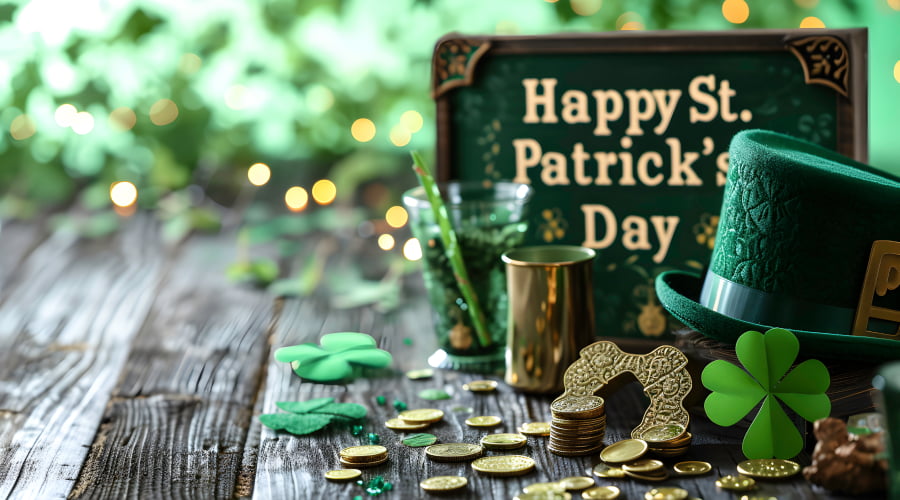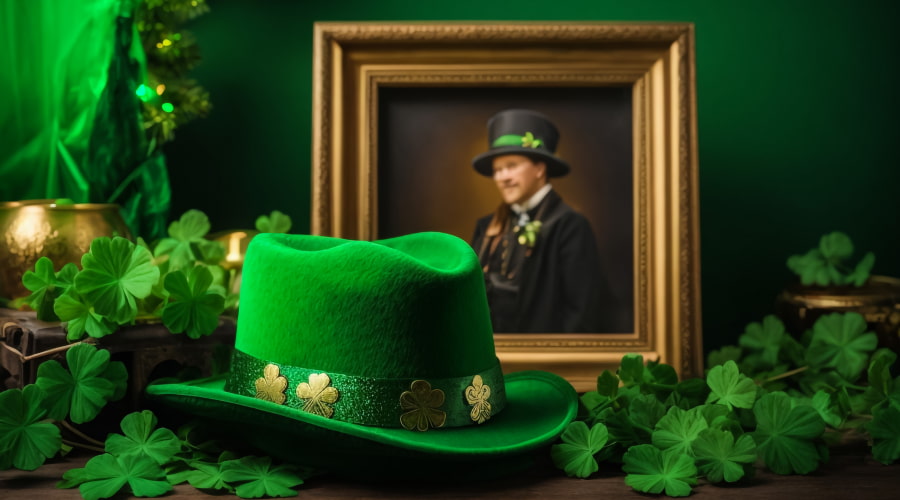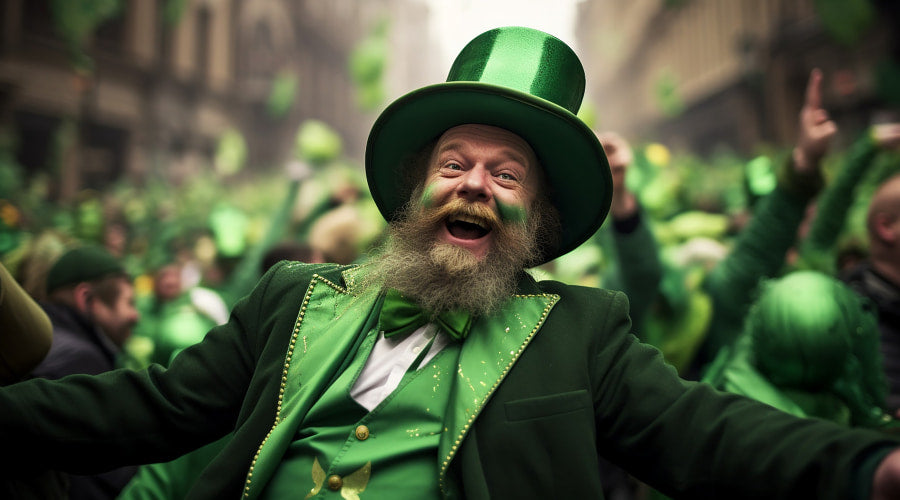St Patrick's Day History and Interesting Facts
St. Patrick's Day has been solemnly celebrated for a century already – that's a fact! Earlier, families went to church and then rejoiced in the holiday. As the fasting stopped, people could eat meat and prepare traditional dishes from Irish bacon and cabbage. Celebrating this day, people drank, ate, and had fun.
However, this day was not always accompanied by noisy fun and parades. St. Patrick's Day was first feasted as a modest religious holiday in 1631 in honor of the patron saint of Ireland.
It is worth noting that Irish immigrants in the United States started to celebrate this day in a completely new way. Since this day fell in the middle of religious fasting, people began to use it to relax from food restrictions and have fun.
We will consider the St. Patrick's Day story, which Saint Patrick is, why the day is named after him, and also tell interesting facts about this holiday.
St. Patrick's Day History
St. Patrick's Day, rooted in Ireland's culture, began as a humble religious celebration in 1631. Initially, families attended church and relished the end of fasting with Irish bacon and cabbage dishes. Fast forward, Irish immigrants in the U.S. transformed it into a vibrant, secular festivity.

Where did St. Patrick's Day Come From?
The origins of St. Patrick's Day trace back to 1631, when it began as a simple religious feast honoring Saint Patrick, the patron saint of Ireland. This celebration marked the anniversary of his death on March 17th. Families attended church services. As fasting concluded, joyous festivities commenced. They featured traditional Irish dishes like bacon and cabbage.
Who was St. Patrick?
St. Patrick, born in Roman Britain, embarked on a remarkable journey. Kidnapped by pirates at 16 and taken to Ireland as a slave, he later escaped. In 432, he returned to Ireland, not as a captive but as a missionary spreading Christianity. Saint Patrick founded monasteries, churches, and schools during his life. He left an indelible mark on Irish history. Legends abound, including stories of him banishing snakes and using the shamrock to illustrate the concept of the Holy Trinity. St. Patrick's Day, celebrated on March 17th, commemorates his passing in 461.
Why do we wear green on St. Patrick's Day?
Green, now synonymous with the St. Patrick's Day story, replaced blue as a symbol of Irish culture. Legend has it that St. Patrick used the shamrock, a green three-leaf clover, to explain the Holy Trinity. Wearing green on this day is a way to honor Ireland and the festive spirit.
When Was the First St. Patrick's Day Celebrated?
St. Patrick's Day has been a part of Irish tradition since the 9th or 10th century. However, the first parade didn't unfold in Ireland but in 1601 in Florida, USA. Initially a quiet religious celebration, it later transformed into a global festivity. Irish immigrants in the United States especially embrace it.
As we delve into the St. Patrick's Day story, these historical threads weave a colorful tapestry. This day blends religious reverence, Irish heritage, and the spirit of celebration.
Leprechauns and St. Patrick's Day
Leprechauns, whimsical beings from Irish folklore, play a charming role in St. Patrick's Day festivities. People often depict these small, elusive creatures as shoemakers. They are part of Irish tales about good and evil. Legend has it that leprechauns accumulate coins by crafting shoes for Irish fairies. These coins are then hidden in pots at the end of rainbows, creating the fabled "pot of gold."
On St. Patrick's Day, leprechaun adds a touch of magic to the celebrations. Their association with the holiday connects to Irish myths and traditions.
St. Patrick's Day Around the World

St. Patrick's Day transcends Irish borders, embraced by people globally with diverse celebrations. Each city has its unique traditions of St. Patrick's Day celebrations:
- Sydney. Immersive family events with an Irish village ambiance featuring food vendors and live music.
- Montreal. Vibrant bands and bagpipes fill the Canadian city, adding a distinctive touch to the festivities.
- Tokyo. Several days of St. Patrick's Day fun, resembling a costume party, accompanied by delicious food and drinks.
- Buenos Aires. Lively concerts, fiestas, parades, and costume contests infuse Argentine flair into the celebration.
- Chicago. Renowned for dyeing its river green since 1962, adding a colorful twist to the festivities.
- Boston. Multi-day concerts and lively gatherings mark St. Patrick's Day in this city.
- Munich. Fun fairs, street food festivals, and live performances extend the celebration over several days.
These global traditions showcase the widespread enthusiasm for St. Patrick's Day. They emphasize the shared joy and diversity of this festive occasion.
Interesting Facts about Saint Patrick's Day

Discover the enchanting layers that make St. Patrick's Day a day of whimsy and tradition. From St. Patrick's Day leprechaun to green rivers. Each facet adds a special touch to this celebrated Irish holiday.
St. Patrick's Day Leprechaun Story
Leprechauns, small beings from Irish folklore, are central to St. Patrick's Day lore. Legend says that these elusive creatures accumulate coins by crafting shoes for Irish fairies. These coins, a coveted treasure, find a hiding spot in pots at the end of rainbows – the fabled "pot of gold."
The Chicago River is Turned Green on St. Patrick's Day
Chicago has dyed its river green every St. Patrick's Day since 1962 in a captivating tradition. This vibrant spectacle reflects the symbolic color of the holiday, creating a unique visual tribute to the Irish festivities. The emerald-green river becomes a living testament to the city's lively embrace of St. Patrick's Day.
What Happens if You're Not Wearing Green?
A playful tradition accompanies St. Patrick's Day history – wearing green to ward off leprechaun pinches. While leprechauns may be mythical, the tradition brings a sense of fun and camaraderie. Those not adorned in green may playfully endure a pinch, adding a lighthearted element to the celebration.
What does the Shamrock Symbolize?
Among the most interesting facts about St. Patrick's Day. The three-leaf clover shamrock holds symbolic significance on St. Patrick's Day. According to legend, St. Patrick used it to explain the Holy Trinity, with the three leaves representing the creatures of God and their unity. The shamrock, therefore, became a cherished national symbol of Ireland.
St. Patrick was Born in Britain
Despite St. Patrick's association with Ireland, he was born in Roman Britain. Kidnapped and taken to Ireland as a slave, he later returned as a missionary. St. Patrick's birthplace adds an intriguing layer to the historical tapestry of this beloved Irish celebration.
Fun Facts about Saint Patrick's Day

Delve into the lighthearted side of St. Patrick's Day with these amusing tidbits. From the original color to Irish tunes in space. Let's unravel some of the fun facts about St. Patrick's Day.
Blue Instead of Green
The original hue of St. Patrick's Day wasn't green but blue! It changed to green in the 19th century, embracing Irish nationalism over the original blue of the Order of St. Patrick.
Debunking the Snake Legend
St. Patrick didn't actually banish snakes from Ireland; there were never any! The legend is likely a metaphor for his conversion of pagan Irish to Christianity.
St. Patrick's Day in Space
Astronaut Chris Hadfield took the festivities to space. He played Irish tunes on St. Patrick's Day, making it a cosmic celebration.
Amid mirth and legends, St. Patrick's Day remains a joyous blend of tradition and laughter.
Conclusion
St. Patrick's Day unfolds as a vibrant chapter in Irish heritage. From its modest beginnings as a religious feast, it transformed into a global celebration. The lively St. Patrick's Day story intertwines with leprechaun tales and traditions worldwide.
Fun facts about St. Patrick's Day add a whimsical touch. It's like the color shift from blue to green and the astronaut's space serenade. This joyous day unites the world in laughter. It emphasizes the fascinating blend of St. Patrick's Day history, folklore, and merriment.
Enhance St. Patrick's Day joy with vibrant flowers! Rosaholics offers delightful bouquets to brighten the celebration. Their blooms add a touch of freshness to the lively spirit of this Irish festivity. Elevate your St. Patrick's Day with Rosaholics' charming flower arrangements. Cheers to the enduring spirit of Irish revelry!
carrusel_1
FAQ
Saint Patrick's Day is an annual religious holiday celebrated in many countries in honor of the Irish patron Saint Patrick. The celebration of this day is since it was Saint Patrick who introduced the Irish to Christianity.
People believed that being in green clothes, the mythical creatures leprechauns were not able to notice people.
One possible reason why leprechauns are associated with St. Patrick's Day is that the first mention of these mythical creatures was in Irish fables. Then Ireland reunited some of its traditions and legends and connected them with one of the main Irish holidays – St. Patrick's Day. Also, the cheerful and kind elf Lil appeared in the Disney film and thanks to this, the leprechaun has become a symbol of St. Patrick's Day and Irish culture.
No, leprechauns are mythical creatures.
According to legend, Saint Patrick, who preached Christianity, chose a three-leaf clover to demonstrate the three images of God, which were connected like a stem and three leaves of a clover.
In 2024, Saint Patrick's Day will be celebrated on March 17th.
Not seen your shipping location? We deliver US Nationwide, visit our Shop All collection to discover the perfect bouquet that best fit your occasion.



















